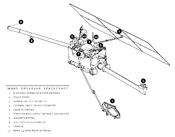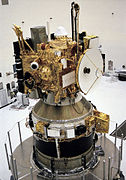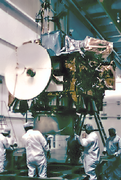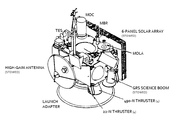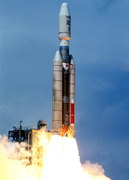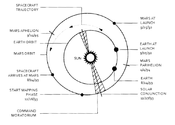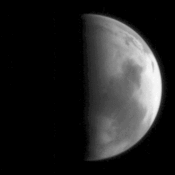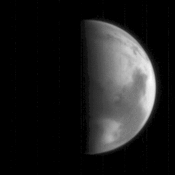- Mars Observer
-
Mars Observer 
Artist rendering of Mars Observer in orbit around Mars.
Operator NASA / JPL Major contractors General Electric Astro Space Mission type Orbiter Satellite of Mars Orbital insertion date 1993-08-24 (intended) Launch date 1992-09-25 17:05:01 UTC
(19 years, 1 month and 22 days ago)Launch vehicle Titan III Launch site Space Launch Complex 40
Cape Canaveral Air Force StationMission duration Failure in transit
(last contact on day 331)
(1993-08-21 01:00 UTC)COSPAR ID 1992-063A Homepage Mars Observer home
Mars Observer archived pageMass 1,018 kg (2,240 lb) Power 1147 W (Solar array / 2 NiCad batteries) The Mars Observer spacecraft, also known as the Mars Geoscience/Climatology Orbiter, was a 1,018-kilogram (2,244 lb) robotic space probe launched by NASA on September 25, 1992 to study the Martian surface, atmosphere, climate and magnetic field. During the interplanetary cruise phase, communication with the spacecraft was lost on August 21, 1993, 3 days prior to orbital insertion. Attempts to re-establish communication with the spacecraft were unsuccessful.
Contents
Mission background
History
In 1984, a high priority mission to Mars was set forth by the Solar System Exploration Committee. Then titled the Mars Geoscience/Climatology Orbiter, the Martian orbiter was planned to expand on the vast information already gathered by the Viking program. Preliminary mission goals expected the probe to provide planetary magnetic field data, detection of certain spectral line signatures of minerals on the surface, images of the surface at 1 meter/pixel and global elevation data.[1]
Mars Observer was originally planned to be launched in 1990 by a Space Shuttle Orbiter. The possibility for an expendable rocket to be used was also suggested, if the spacecraft would be designed to meet certain constraints.[1] On March 12th, 1987, the mission was rescheduled for launch in 1992, in lieu of other backlogged missions (Galileo, Magellan, Ulysses).[2] Along with a launch delay, budget overruns necessitated the elimination of two instruments to meet the 1992 planned launch.[3][4] As the development matured, the primary science objectives were finalized as:[3][5][6]
- Determine the global elemental and mineralogical character of the surface material.
- Define globally the topography and gravitational field.
- Establish the nature of the Martian magnetic field.
- Determine the temporal and spatial distribution, abundance, sources, and sinks of volatiles and dust over a seasonal cycle.
- Explore the structure and circulation of the atmosphere.
Spacecraft design
The Mars Observer spacecraft bus measured 1.1-meters tall, 2.2-meters wide, and 1.6-meters deep. The spacecraft was based on previous satellite designs, originally intended and developed to orbit Earth. The RCA Satcom-Ku-band satellite design was used extensively for the spacecraft bus, propulsion, thermal protection, and solar array. RCA TIROS and DMSP Block 50-2 satellite designs were also utilized in the implementing the Attitude and Articulation Control System (AACS), command and data handling subsystem, and power subsystem, into Mars Observer. Other elements such as the bipropellant components and high-gain antenna were designed specifically for the mission.[7][8][9]
Attitude control and propulsion
- The spacecraft was three-axis stabilized with four reaction wheels and twenty-four thrusters with 1346-kilograms of propellant. The propulsion system is a high thrust, Monomethyl hydrazine/nitrogen tetroxide bipropellant system for larger maneuvers and a lower thrust hydrazine monopropellant system for minor orbital corrections during the mission. Of the bipropellant thrusters, four located on the aft, provide 490-Newtons of thrust for course corrections, control of the spacecraft during the Mars orbital insertion maneuver and large orbit corrections during the mission; another four, located on along the sides of the spacecraft, provide 22-Newtons for controlling roll maneuvers. Of the hydrazine thrusters, eight provide 4.5-Newtons to control orbit trim maneuvers; another eight provide 0.9-Newtons for offsetting, or "desaturating", the reaction wheels. To determine the orientation of the spacecraft, a horizon sensor, a 6-slit star scanner, and five sun sensors were included.[7][9]
Communications
- For telecommunications, the spacecraft included a two-axis gimbaled 1.5-meter, parabolic high-gain antenna, mounted to a 6-meter boom to communicate with the Deep Space Network across the X-band using two GFP NASA X-band transponders (NXTs) and two GFP command detector units (CDUs). An assembly of six low-gain antennas, and a single medium-gain antenna were also included, to be used during the cruise phase while the high-gain antenna remained stowed, and for contingency measures should communications through the high-gain antenna become restricted. When broadcasting to the Deep Space Network, a maximum of 10.66 kilobytes/second could be achieved while the spacecraft could receive commands at a maximum bandwidth of 62.5-bytes/second.[5][7][8][9]
Power
- Power was supplied to the spacecraft through a six panel solar array, measuring 7.0-meters wide and 3.7-meters tall, and would provide an average of 1147-Watts when in orbit. To power the spacecraft while occluded from the Sun, two 42-amp-hour Nickel-Cadmium batteries were included; the batteries would recharge as tthe solar array received sunlight.[5][7][8][9]
Computer
- The computing system on the spacecraft was a retooling of the system used on the TIROS and DMSP satellites. The semiautonomous system was able to store up to 2000 commands in the included 64-kilobytes of Random-access memory, and execute them at a maximum rate of 12.5-commands/second; commands could also provide sufficient autonomous operation of the spacecraft for up to sixty days. To record data, redundant digital tape recorders (DTR) were included and each capable of storing up to 187.5-megabytes, for later playback to the Deep Space Network.[7]
Scientific instruments
Mars Observer Camera (MOC) 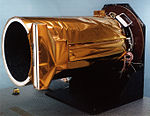
- see diagramObjectives [6] - Obtain global synoptic views of the martian atmosphere and surface to study meteorological, climatological, and related surface changes.
- Monitor surface and atmosphere features at moderate resolution for changes on time scales of hours, days, weeks, months and years.
- Systematically examine local areas at extremely high spatial resolution in order to quantify surface/atmosphere interactions and geological processes.
Consists of narrow-angle and wide-angle telescopic cameras to study the meteorology/climatology and geoscience of Mars. [10]
- Principal investigator: Michael Malin / Arizona State University (website)
- reincorporated on Mars Global Surveyor
Mars Observer Laser Altimeter (MOLA) 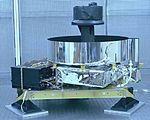
- see diagramObjectives [6] - Provide topographic height measurements with a vertical resolution better than 0.5% of the elevation change within the footprint.
- Provide RMS slope information over the footprint.
- Provide surface brightness temperatures at 13.6 GHz with a precision of better than 2.5K.
- Provide well sampled radar return wave forms for precise range corrections and the characterization of surface properties.
A laser altimeter used to define the topography of Mars. [11]
- Principal investigator: David Smith / NASA Goddard Space Flight Center
- reincorporated on Mars Global Surveyor
Thermal Emission Spectrometer (TES) 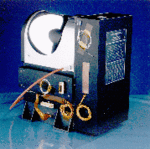
- see diagramObjectives [6] - Determine and map the composition of surface minerals, rocks and ice.
- Study the composition, particle size, and spatial and tempora distribution of atmospheric dust.
- Locate water-ice and carbon dioxide condensate clouds and determine their temperature, height and condensate abundance.
- Study the growth, retreat and total energy balance of the polar cap deposits.
- Measure the thermophysical properties of the martian surface (thermal inertia, albedo) used to derive surface particle size and rock abundance.
- Determine atmoepheric temperature, pressure, water vapor, and ozone profiles, and seasonal pressure variations.
Uses three sensors (Michelson interferometer, solar reflectance sensor, broadband radiance sensor) to measure thermal infrared emissions to map the mineral content of surface rocks, frosts and the composition of clouds . [12]
- Principal investigator: Philip Christensen / Arizona State University
- reincorporated on Mars Global Surveyor
Pressure Modulator Infrared Radiometer (PMIRR) 
Objectives [6] - Map the three-dimensional and time-varying thermal structure of the atmosphere from the surface to 80 km altitude.
- Map the atmospheric dust loading and its global, vertical and temporal variation.
- Map the seasonal and spatial variation of the vertical distribution of atmospheric water vapor to an altitude of at least 35 km.
- Distinguish between atmospheric condensates and map their spatial and temporal variation.
- Map the seasonal and spatial variability of atmospheric pressure.
- Monitor the polar radiation balance.
Uses narrow-band radiometric channels and two pressure modulation cells to measure atmospheric and surface emissions in the thermal infrared and a visible channel to measure dust particles and condensates in the atmosphere and on the surface at varying longitudes and seasons. [13]
- Principal investigator: Daniel McCleese / JPL
- reincorporated on Mars Climate Orbiter
Gamma Ray Spectrometer (GRS) 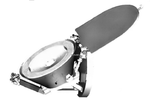
- see diagramObjectives [6] - Determine the elemental composition of the surface of Mars with a spatial resolution of a few hundred kilometers through measurements of incident gamma-rays and albedo neutrons (H, 0, Mg, Al, Si, S, Cl, K, Fe, Th, U).
- Determine hydrogen depth dependence in the top tens of centimeters.
- Determine the atmospheric column density.
- Determine the arrival time and spectra of gamma-ray bursts.
Records the spectrum of gamma rays and neutrons emitted by the radioactive decay of elements contained in the Martian surface. [14]
- Principal investigator: William Boynton / University of Arizona / NASA Goddard Space Flight Center (HEASARC website)
- reincorporated on 2001 Mars Odyssey
Magnetometer and Electron Reflectometer (MAG/ER) 
Objectives [6] - Establish the nature of the mingnetic field of Mars.
- Develop models for its representation, which take into account the internal sources of magnetism and the effects of the interaction with the solar wind.
- Map the martian crustal remanlint field using the fluxgate sensors and extend these in-situ measurements with the remote capability of the electron-reflectometer sensor.
- Characterize the solar wind/Mars plasma interaction.
- Remotely sense the martian ionosphere.
Uses the components of the on-board telecommunications system and the stations of the Deep Space Network to collect data on the nature of the magnetic field and interactions the field may have with solar wind. [15]
- Principal investigator: Mario Acuna / NASA Goddard Space Flight Center
- reincorporated on Mars Global Surveyor
Radio Science experiment (RS) 
Objectives [6] Atmosphere - Determine profiles of refractive index, number density, temperature, and pressure at the natural experimental resolution (approx. 200m) for the lowest few scale heights at high latitudes in both hemispheres on a daily basis.
- Monitor both short term and seasonal variation in atmospheric stratification.
- Characterize the thermal respclnse of the atmosphere to dust loading.
- Explore the thermal structure of the boundary layer at high vertical resolution (approx. 10m).
- Determine the height and peak plasma density of the daytime ionosphere.
- Characterize the small scale structure of the atmosphere and ionosphere.
Gravity - Develop a global, high-reso1ut:ion model for the gravitational field.
- Determine both local and broad scale density structure and stress state of the martian crust and upper mantle.
- Detect and measure temporal changes in low degree harmonics of the gravitational field.
Collects data on the gravity field and the Martian atmospheric structure with a special emphasis on temporal changes near the polar regions.[16]
- Principal investigator: G. Tyler / Stanford University
- reincorporated on Mars Global Surveyor
Mars Balloon Relay (MBR) Planned as augmentation to return data from the penetrators and surface stations of the Russian Mars '94 mission and from penetrators, surface stations, a rover, and a balloon from the Mars '96 mission. [17]
- Principal investigator: Jacques Blamont / Centre National de la Recherche Scientifique
- reincorporated on Mars Global Surveyor
Images of the spacecraft Labeled diagram of Mars Observer.Mars Observer in the Payload Hazardous Servicing Facility.Technician assembling the Mars Observer space probe.Mars Observer in the clean room.Mission profile
Timeline of operations Date Event 1992-09-25Spacecraft launched at 17:05:01 UTC 1993-08-21Communication with spacecraft lost at 01:00 UTC. 1993-08-24Begin Mars orbital insertion maneuvers Time Event 1993-08-24Mars Orbit Insertion maneuver 1993-09-04Elliptical Change Maneuver-1 1993-09-04Elliptical Change Maneuver-2 1993-09-16Elliptical Change Maneuver-3 1993-10-17Transfer to Low Orbit maneuver-1 1993-10-18Transfer to Low Orbit maneuver-2 1993-09-27Mission declared a loss. No further attempts to contact. 1993-12-17Begin mapping phase Items in red were unrealized events.Launch and trajectory
Mars Observer was launched on September 25, 1992 at 17:05:01 UTC by the National Aeronautics and Space Administration from Space Launch Complex 40 at the Cape Canaveral Air Force Station in Florida, aboard a Commercial Titan III CT-4 launch vehicle. The complete burn sequence lasted for 34 minutes after a solid-fuel Transfer Orbit Stage placed the spacecraft into an 11 month, Mars transfer trajectory, at a final speed of 5.28-kilometers/second with respect to Mars.[9]
On August 25, 1992, particulate contamination was found within the spacecraft. After a full inspection, a cleaning was determined necessary and was performed on August 29. The suspected cause of the contamination were measures taken to protect the spacecraft prior to the landfall of Hurricane Andrew which struck the coast of Florida on August 24.[9][18][19]
Diagram of Mars Observer in launch configuration.Diagram of the interplanetary trajectory of Mars Observer.Encounter with Mars
Mars Observer was scheduled to perform an orbital insertion maneuver on August 24, 1993. However due to complications, contact with the spacecraft was lost on August 21, 1993, after a routine operation likely caused a rupture in the bipropellant system, resulting in the loss of the spacecraft. Although none of the primary objectives were achieved, the mission provided interplanetary cruise phase data, collected up to the date of last contact. This data would be useful for subsequent missions to Mars. Science instruments originally developed for Mars Observer were placed on three future orbiters to complete the mission objectives: Mars Global Surveyor launched in 1996, Mars Climate Orbiter launched in 1998, 2001 Mars Odyssey launched in 2001, Mars Reconnaissance Orbiter launched in 2005.
Second MOC image of Mars, acquired one hour after the first. One of few wide-angle images by Mars Observer that were in color.
One of few wide-angle images by Mars Observer that were in color.Intended operations
 Video
VideoOn August 24, 1993, Mars Observer would turn 180-degrees and ignite the bipropellant thrusters to slow the spacecraft, entering into a highly elliptical orbit. Over the next three months, subsequent "transfer to lower orbit" (TLO) maneuvers would be performed as the spacecraft reached periapsis, eventually resulting in an approximately circular, 118-minute orbit around Mars.[20]
The primary mission was to begin on November 23, 1993, collecting data during one Martian year (approximately 687 Earth days). The first global map was expected to be completed on December 16, followed by solar conjunction beginning on December 20, and lasting for nineteen days, ending on January 3, 1994; during this time, mission operations would be suspended as radio contact would not be possible.[20]
Orbiting Mars at an approximate speed of 3.4-kilometers/second, the spacecraft would travel around Mars in a north to south, polar orbit. As the spacecraft circles the planet, horizon sensors indicate the orientation of the spacecraft while the reaction wheels would maintain the orientation of the instruments, towards Mars. The chosen orbit was also sun-synchronous, allowing the daylit side of Mars to always be captured during the mid-afternoon of each Martian Sol. While some instruments could provide a real-time data link when Earth was in view of the spacecraft, data would also be recorded to the digital tape recorders and played back to Earth each day. Over 75-gigabytes of scientific data was expected to be yielded during the primary mission, much more than any previous mission to Mars. The end of the operable life for the spacecraft was expected to be limited by the supply of propellant and the condition of the batteries.[20]
Communications loss
On August 21, 1993, at 01:00 UTC, three days prior to the scheduled Mars orbital insertion, there was an "inexplicable" loss of contact with Mars Observer.[21] New commands were sent every 20 minutes in the hopes that the spacecraft had drifted off course and could regain contact. However, the attempt was unsuccessful.[21] It is unknown whether the spacecraft was able to follow its automatic programming and go into Mars orbit or if it flew by Mars and is now in a heliocentric orbit.
On January 4, 1994, an independent investigation board from the Naval Research Laboratory, announced their findings: the most probable cause in the loss of communication was a rupture of the fuel pressurization tank in the spacecraft's propulsion system.[22] It is believed that hypergolic fuel may have leaked past valves in the system during the cruise to Mars, allowing the fuel and oxidizer to combine prematurely before reaching the combustion chamber. The leaking fuel and gas probably resulted in a high spin rate, causing the spacecraft to enter into the "contingency mode"; this interrupted the stored command sequence and did not turn the transmitter on.[22] The engine was derived from one belonging to an Earth orbital satellite and was not designed to lie dormant for months before being fired.
Quoted from the report [22] "Because the telemetry transmitted from the Observer had been commanded off and subsequent efforts to locate or communicate with the spacecraft failed, the board was unable to find conclusive evidence pointing to a particular event that caused the loss of the Observer. However, after conducting extensive analyses, the board reported that the most probable cause of the loss of communications with the spacecraft on Aug. 21, 1993, was a rupture of the fuel (monomethyl hydrazine (MMH)) pressurization side of the spacecraft's propulsion system, resulting in a pressurized leak of both helium gas and liquid MMH under the spacecraft's thermal blanket. The gas and liquid would most likely have leaked out from under the blanket in an unsymmetrical manner, resulting in a net spin rate. This high spin rate would cause the spacecraft to enter into the "contingency mode," which interrupted the stored command sequence and thus, did not turn the transmitter on.
Additionally, this high spin rate precluded proper orientation of the solar arrays, resulting in discharge of the batteries. However, the spin effect may be academic, because the released MMH would likely attack and damage critical electrical circuits within the spacecraft.
The board's study concluded that the propulsion system failure most probably was caused by the inadvertent mixing and the reaction of nitrogen tetroxide (NTO) and MMH within titanium pressurization tubing, during the helium pressurization of the fuel tanks. This reaction caused the tubing to rupture, resulting in helium and MMH being released from the tubing, thus forcing the spacecraft into a catastrophic spin and also damaging critical electrical circuits."
See also
- Exploration of Mars
- Space exploration
- Unmanned space missions
- Planetary Observer program
References
- ^ a b Eberhart, Jonathon (1986). "NASA Sets Sensors for 1990 Return to Mars". Science News (Society for Science & the Public) 239 (21): 330. JSTOR 3970693.
- ^ Waldrop, M. Mitchell (1987). "Company Offers To Buy NASA A Rocket". Science (American Association for the Advancement of Science) 235 (4796): 1568. Bibcode 1987Sci...235.1568W. doi:10.1126/science.235.4796.1568a. JSTOR 1698285.
- ^ a b "Return to the red planet: The Mars Observer Missio" (PDF) (Press release). Jet Propulsion Laboratory. 1993-08-01. http://ntrs.nasa.gov/search.jsp?R=19950019916&hterms=return+to+the+red+planet&qs=Ntx%3Dmode%2520matchallany%26Ntk%3DAll%26Ns%3DLoaded-Date.
- ^ Eberhart, J. (1988). "An Act of Discovery: On the Road Again". Science News (Society for Science & the Public) 134 (15): 231. doi:10.2307/3973010. JSTOR 3973010.
- ^ a b c d Mark Wade. "Mars Observer". http://astronautix.com/craft/marerver.htm. Retrieved 23 December 2010.
- ^ a b c d e f g h Albee, Arden L. (1988). Workshop on Mars Sample Return Science. Lunar and Planetary Inst.. pp. 25–29. Bibcode 1988msrs.work...25A.
- ^ a b c d e "MARS OBSERVER: PHASE 0 SAFETY REVIEW DATA PACKAGE" (in ENGLISH) (PDF) (Press release). RCA Astro-Electronics. November 17, 1986. http://hdl.handle.net/2060/19870011586. Retrieved 2011-03-20.
- ^ a b c d NASA. "Mars Observer". NASA. http://nssdc.gsfc.nasa.gov/nmc/masterCatalog.do?sc=1992-063A. Retrieved 23 December 2010.
- ^ a b c d e f "MARS OBSERVER PRESS KIT" (in ENGLISH) (Text) (Press release). NASA. SEPTEMBER 1992. http://replay.waybackmachine.org/20040216034435/http://spacelink.nasa.gov/NASA.Projects/Space.Science/Solar.System/Mars.Observer/Press.Kit. Retrieved 2011-03-21.
- ^ "Mars Observer Camera (MOC)". NASA / National Space Science Data Center. http://nssdc.gsfc.nasa.gov/nmc/experimentDisplay.do?id=1992-063A-07. Retrieved 2011-02-19.
- ^ "Mars Observer Laser Altimeter (MOLA)". NASA / National Space Science Data Center. http://nssdc.gsfc.nasa.gov/nmc/experimentDisplay.do?id=1992-063A-04. Retrieved 2011-02-19.
- ^ "Thermal Emission Spectrometer (TES)". NASA / National Space Science Data Center. http://nssdc.gsfc.nasa.gov/nmc/experimentDisplay.do?id=1992-063A-06. Retrieved 2011-02-19.
- ^ "Pressure Modulator Infrared Radiometer (PMIRR)". NASA / National Space Science Data Center. http://nssdc.gsfc.nasa.gov/nmc/experimentDisplay.do?id=1992-063A-05. Retrieved 2011-02-19.
- ^ "Gamma Ray Spectrometer (GRS)". NASA / National Space Science Data Center. http://nssdc.gsfc.nasa.gov/nmc/experimentDisplay.do?id=1992-063A-02. Retrieved 2011-02-19.
- ^ "Magnetometer and Electron Reflectometer (MAG/ER)". NASA / National Space Science Data Center. http://nssdc.gsfc.nasa.gov/nmc/experimentDisplay.do?id=1992-063A-03. Retrieved 2011-02-19.
- ^ "Radio Science (RS)". NASA / National Space Science Data Center. http://nssdc.gsfc.nasa.gov/nmc/experimentDisplay.do?id=1992-063A-01. Retrieved 2011-02-19.
- ^ "Mars Balloon Relay (MBR)". NASA / National Space Science Data Center. http://nssdc.gsfc.nasa.gov/nmc/experimentDisplay.do?id=1992-063A-08. Retrieved 2011-02-19.
- ^ Wilford, John Noble (1992-08-28). "Mishap Delays Mission to Mars". New York Times. http://query.nytimes.com/gst/fullpage.html?res=9E0CE7DF1230F93BA1575BC0A964958260&scp=10&sq=Mars+Observer&st=nyt. Retrieved 2008-06-21.
- ^ Wilford, John Noble (1992-09-26). "U.S. Launches A Spacecraft On a Mars Trip". New York Times. http://query.nytimes.com/gst/fullpage.html?res=9E0CE4DE143FF935A1575AC0A964958260&sec=&spon=&pagewanted=1. Retrieved 2008-06-21.
- ^ a b c "Mars Observer: Mars Orbit Insertion Press Kit" (in ENGLISH) (Text) (Press release). NASA. August 1993. http://replay.waybackmachine.org/20040216034435/http://spacelink.nasa.gov/NASA.Projects/Space.Science/Solar.System/Mars.Observer/Press.Kit.Orbit.Insertion. Retrieved 2011-03-21.
- ^ a b Wilford, John Noble (1993-08-23). "NASA Loses Communication With Mars Observer". New York Times. http://query.nytimes.com/gst/fullpage.html?res=9F0CE0D7163FF930A1575BC0A965958260&sec=&spon=&pagewanted=1. Retrieved 2008-06-17.
- ^ a b c NASA Mars Observer Failure Board Press Release
External links
- Mars Observer launch press kit
- Mars Observer Mission Profile by NASA's Solar System Exploration
- Mars Observer at NSSDC Master Catalog
- The Loss of Mars Observer at Malin Space Science Systems
- NASA - Mars Observer
Failed and cancelled Mars missions Failed at launch 
Failed en route Mars 1 · Zond 2 · Mars 6 · Mars 7 · Phobos 1 · Mars Observer · Nozomi · Mars Climate Orbiter · Mars Polar Lander · Deep Space 2 · Beagle 2Cancelled (year cancelled) Voyager · Marsokhod (Mars 4NM) · Mars sample return (Mars 5NM) · Mars Surveyor 2001 Lander · NetLander · Mars Telecommunications Orbiter · Beagle 3 · Mars Astrobiology Explorer-Cacher (2011)Spacecraft missions to Mars Flybys 
Orbiters Mariner 9 · Mars 2 · 3 · 5 · Viking 1 · 2 · Phobos 2 · Mars Global Surveyor · 2001 Mars Odyssey · Mars Express · Mars Reconnaissance Orbiter
Landers Mars 3 · Viking 1 · 2 · Mars Pathfinder · Phoenix
Rovers Planned missions Mars Science Laboratory (2011) · MetNet · MAVEN (2013) ·
ExoMars static lander and rover · ExoMars Trace Gas Orbiter (2016) · Northern LightUnplanned missions Related topics Exploration · Colonization · Failed Mars missions · Mars Scout Program
Bold italics indicate active missions Categories:- Mars missions
Wikimedia Foundation. 2010.


